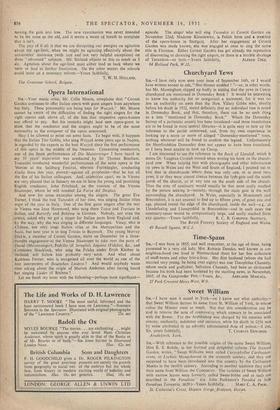Churchyard Yews
have only now seen your issue of September 14th, or I would have written sooner to ask, "Has Homer nodded ? "—or, in other words, has Mr. Massingham slipped up badly in stating that the yews in Cusop churchyard are mentioned in Domesday Bock? It would be interesting to know his authority for so categorical a statement, for it was no less an authorilty on trees than the Hon. Vieary Gibbs who, shortly. before his death in 1932, stated definitely that no individual tree is noted in Domesday Book, and that, therefore, Acre can be no such thing as a tree "mentioned in Domesday Book." Where the Domesday Survey of a particular county has been translated—and these translations are to be found in most central libraries—it is quite easy to turn up the reference to the parish concerned, and, from my own experience in looking up a score or more of alleged "Domesday-mentioned" trees, nothing whatever will be found to confirm the legend. Unfortunately the Herefordshire Domesday does not appear to have been translated, so I have been unable to look up Cusop.
I am interested to see the reference to the Book of Llandafl, which it seems Dr. Vaughan Cornish missed when writing his book on the church- yard yew. When helping him with photographs and other information on yews in Wales and the West and South of England, I pointed out to him that in churchyards where there was only one, or at most two, yews, it or they were almost always between the lycit-gate and the south porch of the church, or at any rate on the south side of the church. Thus the area of sanctuary would usually be that most easily reached by the person seeking it—namely, through the main gate in the wall surrounding the churchyard. In Wales, especially in Monmouth and Breconshire, it is not unusual to find up to fifteen yews, of great size and age, planted round the edge of the churchyard, inside the at Llandefaelog and Llanspyddid in Breconshire—and in such cases the sanctuary-space would be comparatively large, and easily reached from any quarter.—Yours faithfully, R. C. B. GARDNER, Secretary, The Royal Forestry Society of England and Wales. 49 Russell Square, W.C.1.














































































 Previous page
Previous page